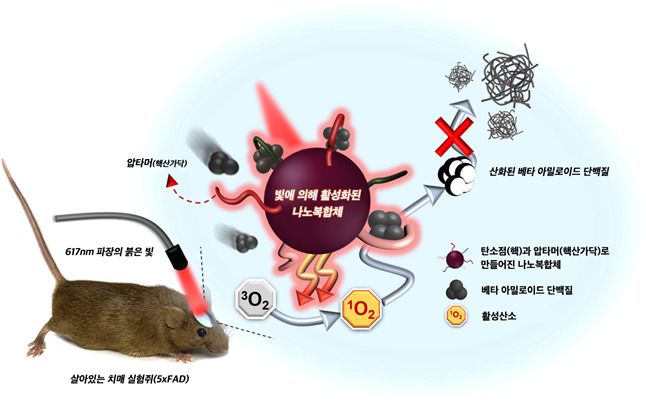[대전=뉴스핌] Reporter Kim Tae-jin = The Korea Basic Science Institute (KBSI) announced on the 6th that the research team of Dr. Hyun-Oh Kang of the Materials Analysis Research Department and the research team of Professor Chan-beom Park of the Department of Advanced Materials Engineering at KAIST developed a nanocomposite that suppresses the formation of amyloid plaques, known as the cause of dementia.
Since this nanocomposite is activated only when it receives red light, it can suppress the formation of amyloid plaques by irradiating light at a specific location for a required period of time, and it is expected to be used in a new type of dementia treatment in the future.
Amyloid plaques are clusters of proteins found in the brains of patients with Alzheimer’s dementia, and are made by agglomerating beta amyloid proteins in the form of threads.
 |
| The process by which nanocomposites inhibit amyloid plaque formation[사진=KBSI] 2021.01.06 [email protected] |
As amyloid plaques continue to accumulate in the brain, neurotoxicity is caused and the signaling system of neurons in the brain is destroyed, leading to dementia.
Until now, research on inhibiting the aggregation of beta amyloid protein for the treatment of Alzheimer’s dementia has been continued, but this study was the first to prove the inhibitory efficacy through animal experiments by developing a nanocomposite that can target the treatment location with light and control the time. to be.
The research team conducted an experiment with an animal model of dementia (5xFAD) that simultaneously contains major dementia genes. After injecting the nanocomposite solution into one side of the brain of a living rat, a red light (wavelength 617 nm), which had a high permeability enough to reach deep inside the brain, was irradiated for 2 hours.
The nanocomposite activated by the light generated free radicals, splitting amyloid plaques finely and inhibiting reaggregation and new formation of amyloid plaques.
The developed nanocomposite has a size of less than 5 nm (nanometers) and is a form in which nucleic acid strands are bound to a ball-shaped nucleus. The nucleus of the nanocomposite is mainly composed of carbon, which is also called’carbon dot’, and is characterized by low toxicity to humans.
Nucleic acid strands called’Aptamers’ attached to the nucleus play a role in strongly sticking to the beta amyloid protein.
Since the nanocomposite has been confirmed to be effective in the complex neurophysiological environment of the living mouse brain, it is easy to apply it to the development of dementia treatments in the future.
 |
| Researchers 2021.01.06 [email protected] |
Dr. Hyeon-Oh Kang of the Research Institute for Basic Science said, “In the development of cranial nerve-related treatments, the key is whether the treatment can pass through the cerebral vascular barrier that protects the cranial nerve cells from foreign substances. The newly developed nanocomposite is based on carbon. “It is highly likely to cross the barrier, and we expect it to lead to a new nanocomposite that can treat Alzheimer’s dementia.”
Shin Hyung-sik, head of the Institute for Basic Science Support, said, “Our country has entered an aging society at a very rapid pace and inevitably needs a national response to increasing aging-related diseases.” “We have completed the KBSI aging research facility, including facilities, and we will continue to conduct follow-up research on aging through the biodisaster analysis technology development project, which is KBSI’s main business, while actively utilizing this infrastructure.”
This research was carried out with the support of the National Research Foundation of Korea (creative research, basic research on individual science and engineering) and KBSI (Biodisaster Analysis Technology Development Project).
KAIST Professor Chanbeom Park’s research team conducted a study on the synthesis and characterization of nanocomposites, while Dr. Hyunoh Kang’s research team at KBSI conducted a study on the efficacy of nanocomposites through the dementia animal model.
The research results were recently published in the international academic journal’ACS Nano’.
